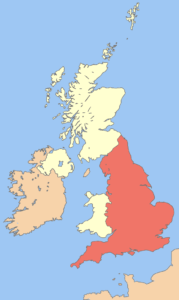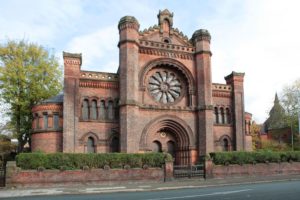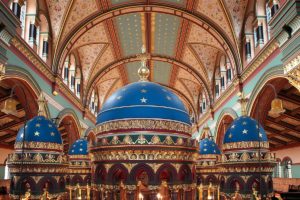 After the Norman Conquest of 1066, a number of Jews came to England from Rouen in France as money-lenders. In the later 12th century, members of the Jewish community in Lincoln settled in York.
After the Norman Conquest of 1066, a number of Jews came to England from Rouen in France as money-lenders. In the later 12th century, members of the Jewish community in Lincoln settled in York.
The first record of Jews living in England dates from Norman times. Just after 1066, William the Conqueror invited a group from Rouen to bring their commercial skills and incoming capital to England. It was to become, to say the least, an ambiguous relationship. During Henry II’s reign, Jews lived on good terms with their Christian neighbours. They helped fund a large number of the abbeys and monasteries and were allowed to take refuge there in times of commotion which came from time to time for religious or commercial reasons.
 At the end of the 12th century, as part of an epidemic of religious fervour during preparations for Richard the Lionheart’s Third Crusade against the Saracens, massacres of Jews were staged at Stamford fair, in Bury St Edmunds and, most notoriously, in York. In 1190 the city’s Jews were given refuge in Clifford’s Tower at York Castle only to be besieged by a mob demanding they convert to Christianity. Most of those inside committed suicide; those who surrendered were slaughtered. Edward I then banished the Jews from England.
At the end of the 12th century, as part of an epidemic of religious fervour during preparations for Richard the Lionheart’s Third Crusade against the Saracens, massacres of Jews were staged at Stamford fair, in Bury St Edmunds and, most notoriously, in York. In 1190 the city’s Jews were given refuge in Clifford’s Tower at York Castle only to be besieged by a mob demanding they convert to Christianity. Most of those inside committed suicide; those who surrendered were slaughtered. Edward I then banished the Jews from England.
 In the middle of the 17th century, around 300 Marano merchants – Spanish and Portuguese Jews – settled in London. In 1701 they erected the country’s first synagogue, Bevis Marks, the only building in Europe where Jewish worship has continued without interruption for more than 300 years. “The Jew Bill” was introduced in 1753 to allow them to be naturalised as British citizens, but this did not pass and it was not until 1890, that all restrictions were lifted.
In the middle of the 17th century, around 300 Marano merchants – Spanish and Portuguese Jews – settled in London. In 1701 they erected the country’s first synagogue, Bevis Marks, the only building in Europe where Jewish worship has continued without interruption for more than 300 years. “The Jew Bill” was introduced in 1753 to allow them to be naturalised as British citizens, but this did not pass and it was not until 1890, that all restrictions were lifted.
From the 1880s onwards, the pogroms in Germany, Poland and Russia caused many Jews to flee. By 1919, the Jewish population had increased to about 250,000 primarily in cities like London, Manchester and Liverpool. They built kosher businesses, welfare networks, Jewish schools and cultural bodies.
And though the nation did not open its arms unreservedly to Jewish refugees fleeing the Nazi regime in the 1930s, it did allow some 40,000 Jews from Austria and Germany to settle in Britain along with 50,000 Jews from Italy, Poland, and elsewhere in Eastern Europe – and the 10,000 Kindertransport children rescued on the eve of war. Orphans, homeless children, and the children of people in concentration camps were given priority on the transports, which lasted until as late as 1940.
Sir Nicholas George Winton, was a British banker and humanitarian who established an organisation to rescue children at risk from Nazi Germany. Winton supervised the rescue of 669 children, from Czechoslovakia on the eve of World War II. Winton found homes for the children and arranged for their safe passage to Britain. Major Francis Edward Foley was a British Secret Intelligence Service officer. As a passport control officer for the British embassy in Berlin, Foley bent the rules and helped thousands of Jewish families escape from Nazi Germany after Kristallnacht and before the outbreak of the Second World War.

Today there are about 350,000 Jews in the UK – around two-thirds in London, with around 40,000 in Manchester and significant communities in Leeds, Glasgow, Brighton, Liverpool, Birmingham, Bournemouth, Gateshead and Southend. Manchester is the bastion of the British Jewish community, with a Jewish population of approximately 30,000. The city has a large population of ultra-Orthodox, who are especially concentrated in the areas of Prestwich and Broughton Park.
The Jewish community has split into different groups. The largest body is the United Synagogue with more than 35,000 families. These include: the Union of Orthodox Hebrew Congregations, Federation of Synagogues, as well as the Reform Synagogues of Great Britain, and a Union of Liberal and Progressive Synagogues.